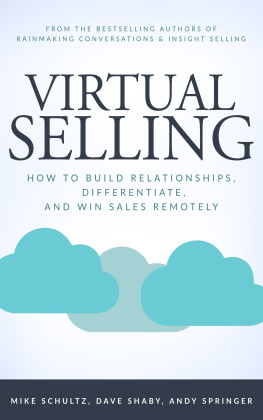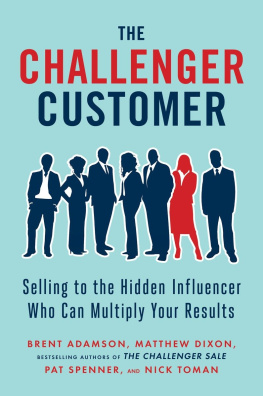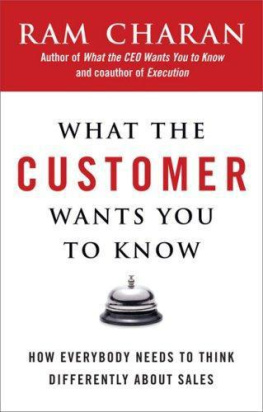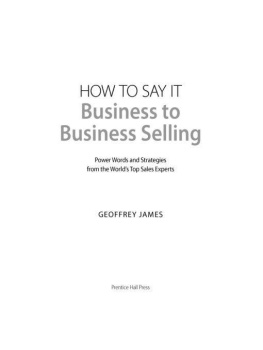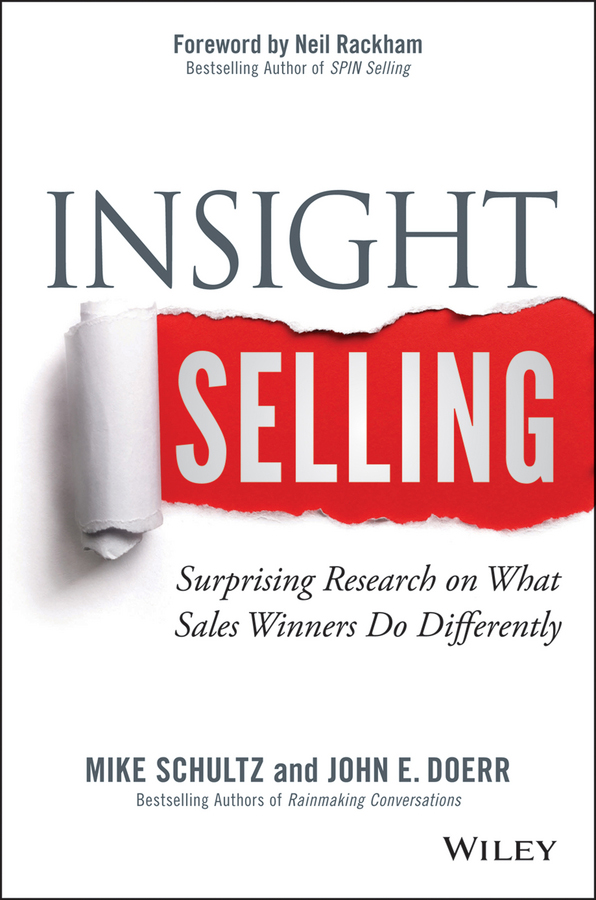
Contents
List of Illustrations
List of Tables
Pages
Guide
Insight Selling
Surprising Research on What Sales Winners Do Differently
Mike Schultz
John E. Doerr
Cover image: iStock / BrianAJackson
Cover design: Wiley
Copyright 2014 by RAIN Group. All rights reserved.
Published by John Wiley & Sons, Inc., Hoboken, New Jersey.
Published simultaneously in Canada.
No part of this publication may be reproduced, stored in a retrieval system, or transmitted in any form or by any means, electronic, mechanical, photocopying, recording, scanning, or otherwise, except as permitted under Section 107 or 108 of the 1976 United States Copyright Act, without either the prior written permission of the Publisher, or authorization through payment of the appropriate per-copy fee to the Copyright Clearance Center, 222 Rosewood Drive, Danvers, MA 01923, (978) 750-8400, fax (978) 646-8600, or on the web at www.copyright.com. Requests to the Publisher for permission should be addressed to the Permissions Department, John Wiley & Sons, Inc., 111 River Street, Hoboken, NJ 07030, (201) 748-6011, fax (201) 748-6008, or online at www.wiley.com/go/permissions.
Limit of Liability/Disclaimer of Warranty: While the publisher and author have used their best efforts in preparing this book, they make no representations or warranties with the respect to the accuracy or completeness of the contents of this book and specifically disclaim any implied warranties of merchantability or fitness for a particular purpose. No warranty may be created or extended by sales representatives or written sales materials. The advice and strategies contained herein may not be suitable for your situation. You should consult with a professional where appropriate. Neither the publisher nor the author shall be liable for damages arising herefrom.
For general information about our other products and services, please contact our Customer Care Department within the United States at (800) 762-2974, outside the United States at (317) 572-3993 or fax (317) 572-4002.
Wiley publishes in a variety of print and electronic formats and by print-on-demand. Some material included with standard print versions of this book may not be included in e-books or in print-on-demand. If this book refers to media such as a CD or DVD that is not included in the version you purchased, you may download this material at http://booksupport.wiley.com. For more information about Wiley products, visit www.wiley.com.
ISBN 978-1-118-87535-3 (cloth);
ISBN 978-1-118-87501-8 (ebk);
ISBN 978-1-118-87506-3 (ebk)
For my son, Ari, and his congenital heart defect warrior brothers and sisters everywhere.
Mike Schultz
For Mom.
John E. Doerr
Foreword
A mixed blessing of my job is that I get to review a lot of sales books. Roughly once a week I receive a manuscript from a hopeful author or publisher, asking me for comments and feedback. Of course, what they are really asking for is a rave review that will help the book sell. Reading all these expectant winners, looking for good things to say, can be a challenging task. Im often tempted to reply with the comment often, but wrongly, attributed to Samuel Johnson: Your work is both good and original. Unfortunately the parts that are good are not original, and the parts that are original are not good. On the plus side, it does mean that I see a lot of ideas before they become public and I get a good sense of current trends in sales thinking. On the downside, for every book that I can honestly endorse, I kiss a whole pondfull of literary frogs.
I ask you to forgive me a moments bitching if I pick out a particularly unhelpful trend in many of these about-to-become-best-selling business books, especially those in sales, that use what I call the Armageddon selling formula. The approach goes something like this: Everything youve ever learned about sales is wrong and, unless you stop doing it instantly, your sales efforts will shortly die in agony. There is, however, one simple cure that I have discovered. It is... and here the author puts in a pitch for the appropriate magic bullet, such as my prospecting method, my selection system, our funnel management process, or our trademarked social media analyticstake your pick. The reason why I mention the Armageddon formula for writing a best seller is that Mike Schultz and John E. Doerrs new book is mercifully free of it. They go out of their way to show that many, if not most, of the skills, knowledge, and selling methods we have learned over the years will continue to matter in the future. Admittedly our present ways of doing things will need to be refocused and retuned to align them with the rapidly changing sales world, but existing methods are not outdated and are certainly not useless. Our present processes and procedures are a robust base on which we can build better selling for the future. Thats an unusual message in a world where most sales books and sales gurus tell you to start by throwing out everything.
The Armageddon approach to sales doesnt help anyone. When, for example, a serious journal like the Harvard Business Review publishes an article titled The End of Solution Sales, it damages the credibility of all involved. The sales field has been growing up nicely in recent years: It can live without this kind of overstatement. As Schultz and Doerr point out, solution selling (or consultative selling, as I prefer to call it) isnt dead or finished; it just needs to adapt to the new sales world. They set out a convincing road map for how to achieve this.
The majority of experienced salespeople would agree that a lot of our existing wisdom is good while readily admitting that some things have become outdated and must change. That should not be, in itself, a controversial issue. The hard part, as Insight Selling explains, is deciding what to keep, what to change, and what to discard. Take relationships, for example. The traditional wisdom has long taught that relationship building is the foundation of all business-to-business selling and much of consumer selling, too. However, particularly since the publication of The Challenger Sale in 2011, the Armageddon enthusiasts have been widely putting it about that relationships have become unimportant and that relationship selling is in its death throes. Again, nothing could be further from the truth. What has changed is the way customers form relationships. In the past, the sequence was for salespeople to build the relationship first and then to sell. Today few customers have the time or the inclination to build relationships before the sale. Instead, the relationship is the reward that customers give to salespeople who have created value for them. So, the sale comes first and the relationship building starts from there. Thats very different from the Armageddon selling position that relationships are unimportant, just because they are no longer built in the same way before the first sale.
Schultz and Doerr lay out a convincing case for which parts of current practice must change and which need gentle retuning to work better in the new selling world. They base their recommendations on research and, better still for me, on the kind of research design I like. Too much sales research rests on the black-versus-white methodology of comparing extremes. So, top performers are compared with poor, good practice with bad, successful companies with unsuccessful. In my experience this method reveals much more about failure than about success. Give me research any day that compares winners with those who almost won. Thats how you learn about those all-important little extras that separate those who make it to the top. In testing the models and recommendations in
Next page

